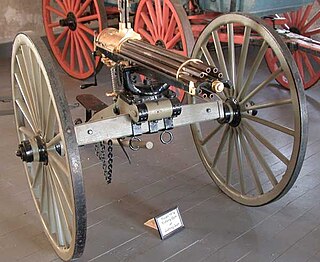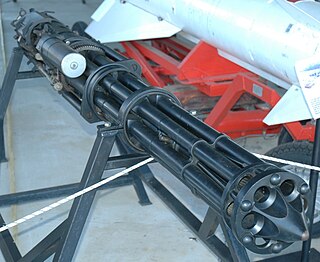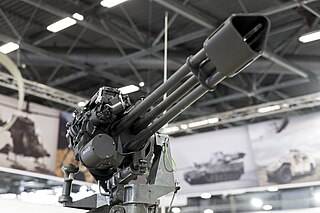
The Gatling gun is a rapid-firing multiple-barrel firearm invented in 1861 by Richard Jordan Gatling. It is an early machine gun and a forerunner of the modern electric motor-driven rotary cannon.

A machine gun (MG) is a fully automatic and rifled firearm designed for sustained direct fire with rifle cartridges. Other automatic firearms such as automatic shotguns and automatic rifles are typically designed more for firing short bursts rather than continuous firepower and are not considered true machine guns. Submachine guns fire handgun cartridges rather than rifle cartridges, therefore they are not considered machine guns, while automatic firearms of 20 mm (0.79 in) caliber or more are classified as autocannons rather than machine guns.

The M61 Vulcan is a hydraulically, electrically, or pneumatically driven, six-barrel, air-cooled, electrically fired Gatling-style rotary cannon which fires 20 mm × 102 mm rounds at an extremely high rate. The M61 and its derivatives have been the principal cannon armament of United States military fixed-wing aircraft for over sixty years.

A revolver cannon is a type of autocannon, commonly used as an aircraft gun. It uses a cylinder with multiple chambers, similar to those of a revolver handgun, to speed up the loading-firing-ejection cycle. Some examples are also power-driven, to further speed the loading process. Unlike a rotary cannon, a revolver cannon only has a single barrel, so its spun weight is lower. Automatic revolver cannons have been produced by many different manufacturers.
The M134 Minigun is an American 7.62×51mm NATO six-barrel rotary machine gun with a high rate of fire. It features a Gatling-style rotating barrel assembly with an external power source, normally an electric motor. The "Mini" in the name is in comparison to larger-caliber designs that use a rotary barrel design, such as General Electric's earlier 20 mm M61 Vulcan, and "gun" for the use of rifle ammunition as opposed to autocannon shells.

The Gryazev-Shipunov GSh-6-23 is a six-barreled 23 mm rotary cannon used by some modern Soviet/Russian military aircraft.
The Gryazev-Shipunov GSh-23 is a twin-barreled 23 mm autocannon developed in the Soviet Union, primarily for military aircraft use. It entered service in 1965, replacing the earlier Nudelman-Rikhter NR-23 and Rikhter R-23.

The Gryazev-Shipunov GSh-6-30 is a Russian 30 mm rotary cannon aircraft-mounted and naval autocannon used by Soviet and later CIS military aircraft. The GSh-6-30 fires a 30×165mm, 390 g projectile.

A rotary cannon, rotary autocannon, rotary gun or Gatling cannon, is any large-caliber multiple-barreled automatic firearm that uses a Gatling-type rotating barrel assembly to deliver a sustained saturational direct fire at much greater rates of fire than single-barreled autocannons of the same caliber. The loading, firing and ejection functions are performed simultaneously in different barrels as the whole assembly rotates, and the rotation also permits the barrels some time to cool. Rotary cannons, external or self-driven are used in aircraft over reciprocating bolt autocannons which are more prone to jamming in high g environments. The rotating barrels on nearly all modern Gatling-type guns are powered by an external force such as an electric motor, although internally powered gas-operated versions have also been developed.

The XM214 Microgun is an American prototype 5.56 mm rotary-barreled machine gun. It was designed and built by General Electric. The XM214 was a scaled-down smaller and lighter version of the M134 Minigun, firing M193 5.56×45mm ammunition.

The GAU-19/A is an electrically driven, three-barrel rotary heavy machine gun that fires the .50 BMG cartridge.

The Yakushev-Borzov YakB-12.7 mm is a remotely controlled 12.7×108mm caliber four-barrel rotary heavy machine gun developed by the Soviet Union in 1973 for the Mil Mi-24 attack gunship and low-capacity troop transporter, with 1470 rounds, which can also be mounted in GUV-8700 machine-gun pods with 750 rounds. It has a high rate of fire and is also one of the few self-powered guns of the Gatling type.

A multiple-barrel firearm is any type of firearm with more than one gun barrel, usually to increase the rate of fire or hit probability and to reduce barrel erosion or overheating.
The Fokker-Leimberger was an externally powered, 12-barrel rifle-caliber rotary gun developed in Germany during the First World War. The action of the Fokker-Leimberger differed from that of a Gatling in that it employed a rotary split-breech design, also known as a "nutcracker".
The XM133 Minigun is a 6-barreled Gatling-type machine-gun. The weapon is a self-powered, gas-operated variant of the M134 Minigun. It fired over 3000 rpm but was not put into production.
Eli gun is an Indonesian six-barrel rotary machine gun made by local manufacturer PT Komodo Armament Indonesia. It can be used for various land, air, and sea vehicles. As a modular system, it is easily adapted to any existing platform. It uses 7.62x51 mm NATO ammunition.
Gryazev-Shipunov may refer to:

Berserk is an unmanned remotely controlled combat complex that was developed in the Republic of Belarus in 2018. The combat complex is equipped with two four-barrel rapid-firing aircraft machine guns GShG-7.62 and designed for engagement of small-size UAVs and enemy troops. For the first time, Berserk was presented at the parade of troops of the Minsk garrison on July 3, 2019 in honor of Independence Day of the Republic of Belarus.

A repeating firearm or repeater is any firearm that is capable of being fired repeatedly before having to be manually reloaded with new ammunition from the magazine.
The M134 Minigun is an American six-barrel rotary machine gun.













